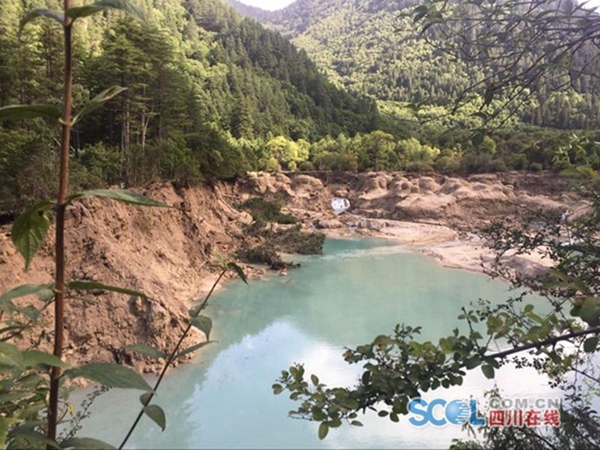|
|
| The Sparkling Lake, one of the most popular scenic spots in the Jiuzhaigou National Park, was found dried up after the M 7.0 earthquake hit 3.5 km away from the valley on Wednesday, August 9, 2017. [Photo:scol.com] |
While mourning the dead and tending to the injured continues after this week’s magnitude 7.0 earthquake in Sichuan province, authorities are saying that the area’s scenic wonders and the local economy also are victims of the natural disaster, centered in scenic Jiuzhaigou.
Twenty-four people died as a result of the Tuesday night earthquake and 493 people were injured, including about 45 seriously wounded, provincial government officials said on Friday.
Two days later, the famous Nuorilang Waterfalls in Jiuzhaigou collapsed.
Nuorilang, with a height of 24.5 meters and width of 270 meters, was China’s widest waterfall and also was chosen by netizens as one of China’s most spectacular. Jiuzhaigou Valley is a UNESCO World Heritage Site.
Li Lin, a guide in the Jiuzhaigou area, said he realized how bad the quake was when he heard that a young couple from Wuhan, Hubei province, were crushed by falling stones.
“The Wenchuan earthquake (also in Sichuan, in 2008) did not wreak havoc here. But this time, many people will remember the tragedy of the couple and cringe at the thought of visiting Jiuzhaigou,” said Li, a middle-aged guide who has worked in Jiuzhaigou for 12 years.
As the couple from Wuhan were approaching a hotel in the area, falling rocks smashed their car. The wife died instantly and the husband managed to push their daughter, a sixth-grader, out of a window before he died, local media reported.
On Wednesday, the management committee of Jiuzhaigou announced it would temporarily close the scenic spot. By Friday, all 61,500 tourists in Jiuzhaigou had left for home, officials said.
“The earthquake is a heavy blow to Sichuan tourism since tourists won’t come to Jiuzhaigou this year,” said an official from the Sichuan Provincial Tourism Development Commission who asked not to be named.
It will take time for tourism to rebound, as in the case of the Wenchuan earthquake, which killed over 80,000, he said. “After the Wenchuan earthquake, fewer tourists visited Sichuan in the latter half of 2008. But as people forgot the quake the next year, the number of tourists gradually rose.”
During the seven-day National Day holiday running from Oct 1 to 7 last year, Jiuzhaigou was so packed with tourists each day that its administrative committee had to limit the number entering the scenic spot.
In 2016, Sichuan’s tourism earnings surpassed 770 billion yuan ($115.5 billion), more than 800 million yuan of which came from Jiuzhaigou, according to the Sichuan tourism commission.
Follow this news feed: East Asia






